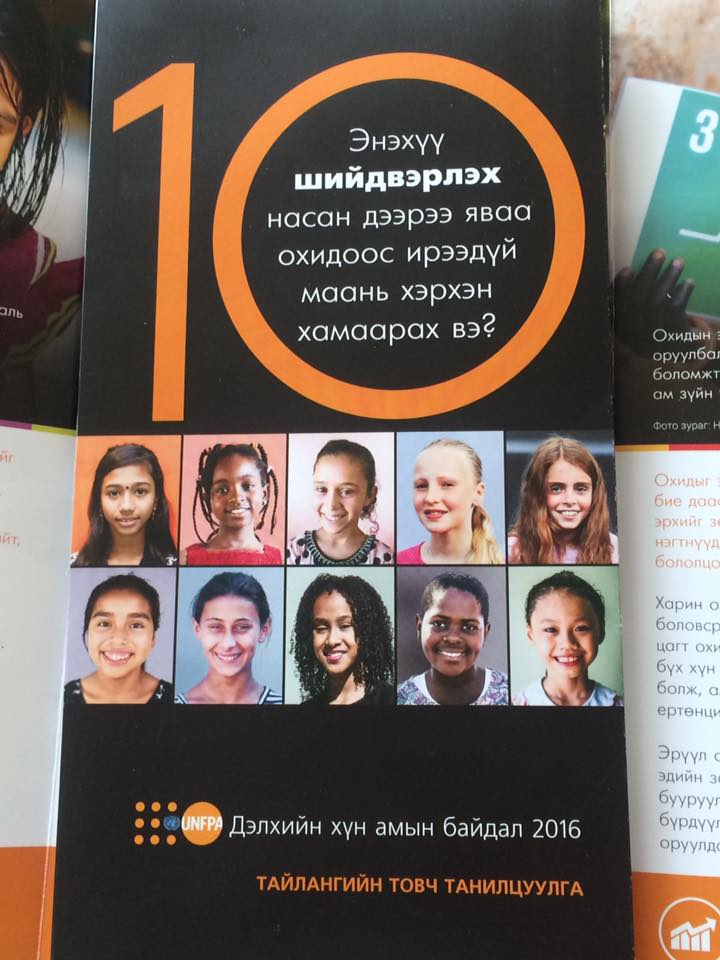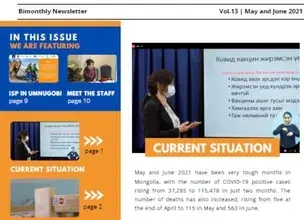Press Release - November 1, 2016, "10: How our future depends on a girl at this decisive age"
Ulaanbaatar — Not investing in girls sufficiently enough can threaten the world’s ambitious development agenda, warns UNFPA, the United Nations Population Fund, in The State of World Population 2016, released today.

Practices that harm girls and violate their human rights--starting at age 10--prevent them from realizing their full potential as adults and from contributing to the economic and social progress of their communities and nations. Without their contribution, the United Nations Agenda 2030 for Sustainable Development and its accompanying 17 Sustainable Development Goals may never be achieved.
Ten is a pivotal age for girls everywhere, as puberty approaches. In some parts of the world, a girl at this age enjoys limitless possibilities and begins making choices that will influence her education and, later, her work life. But in other parts, a girl who goes through puberty is suddenly seen as a commodity that may be bought, sold or traded, the UNFPA report shows. She may be forced to marry, pulled out of school and expected to start bearing children and begin a lifetime of servitude.
“Impeding a girl’s safe, healthy path through adolescence to a productive and autonomous adulthood is a violation of her rights,” UNFPA Executive Director Dr. Babatunde Osotimehin says. “But it also takes a toll on her community and nation. Whenever a girl’s potential goes unrealized, we all lose.”
The new development agenda, endorsed by world leaders in 2015, is the blueprint for countries’ social and economic progress for 15 years. It aims for equitable development that leaves no one behind. Removing the barriers that hold 10-year-old girls back today will increase the chances that the agenda will be a success, the report argues.
The State of World Population report notes that of the 125 million 10-year-olds today, 60 million are girls who are systematically disadvantaged at the global level as they move through adolescence into adulthood. Girls are less likely than boys to complete formal schooling at the secondary and university levels, are more likely to be in poorer physical and mental health, and will find it harder to get paid jobs.
The range of proven policy options available to governments has grown over the past decade. These include banning harmful practices, such as child marriage and providing cash transfers to parents of girls in poor households to help defray costs of schooling, and, thus keep girls in school longer. They also include providing life-skills training and age-appropriate comprehensive sexuality education to girls approaching puberty.
The challenge now, UNFPA’s State of World Population report says, is to scale up these interventions to reach more girls, especially the poorest and most vulnerable, by age 10.
In Mongolia, there are 25,000 girls aged 10, and 225,787 between the ages of 10-19. School enrolment rates are high for girls, at 95% (primary school) and 88% (secondary school) respectively. Mongolia has also been successful in ensuring developmental gains with special attention to girls in the past years. However, Mongolia’s 10 year old girls are facing unique challenges advancing into adolescence. Consider that current statistics show high teenage pregnancies and that for every 1,000 girls (between the ages of 15-19), there are 40.4 childbirths. Compare this to countries within the region or with similar incomes: Turkey- 29.3, Malaysia- 13.3, and Singapore- 4. Correspondingly, unwanted pregnancy is high among teenagers, and 14.1 % of the girls who become pregnant between the ages of 15-19 have abortions. And as for knowledge and practice of family planning, 36.4% of the girls between the ages of 15-19 have unmet need of contraception and do not have knowledge about family planning. While a comprehensive study nationwide on the prevalence of violence against women and girls is yet to be conducted, it is reported that nearly 88.3 % of victims of domestic violence are women, 40 % of whom are as young as 15 up to 34.
Each year of education delivers an additional 11.7 per cent uplift in wages in later life for girls (compared with 9.6 per cent for men). The report reveals potential individual total income gains over the next 15 years resulting from investments in 10-year old girls in selected low and middle income countries. With investment in her future, a girl in Mongolia would have the potential to earn 18,470 USD from 2015-2030. Without investment, it would only be 8,784 USD.
“How we invest in and support 10-year-old girls today will determine what our world will look like in 2030,” Dr. Osotimehin says. “With support from family, community and nation, and the full realization of her rights, a 10-year-old girl can thrive and help bring about the future we all want.”
Key statistics
• Nine out of 10 10-year-old girls live in developing countries, and one in five lives in a least developed country: one in five is in India, and one in eight in China.
• If all the 10-year-old girls who drop out of school or do not attend school in developing countries completed secondary education, they would trigger a $21 billion annual dividend.
• Ten per cent of 5-to-14 year-old girls do more than 28 hours of household chores per week, twice that of boys. Three in four girl labourers are unpaid.
• Every day, an estimated 47,700 girls are at risk of being married before age 18.




